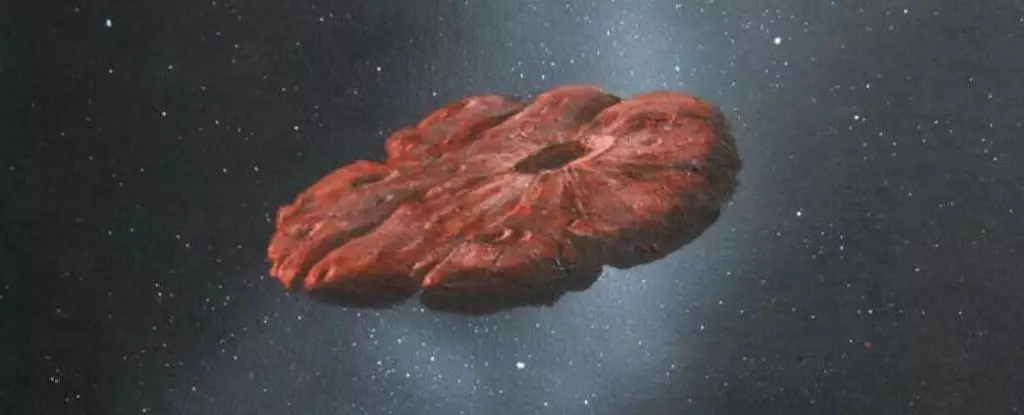In late 2017, our understanding of celestial dynamics was forever altered by the rapid passage of an enigmatic object known as ‘Oumuamua. Discovered by astronomers who raced to gather data on this unprecedented visitor, ‘Oumuamua presented itself as a marvel of cosmic engineering—a quarter-mile-long, elongated anomaly streaking through the Solar System at astonishing speeds. Its name, meaning “scout” in Hawaiian, perfectly encapsulates its role: a messenger from the depths of interstellar space, conveying secrets from other solar systems that humans have yet to grasp.
This fascinating traveler emerged not from the cosmic dust of our Solar System, but rather from the gravitational embrace of another star, making it the first confirmed interstellar object (ISO) detected passing through our celestial neighborhood. With immense implications for our understanding of the universe, ‘Oumuamua raises fundamental questions: How many more of these interstellar wanderers exist? What can we learn from them? And, perhaps most intriguingly, why is it so challenging to observe them?
The Invisible Universe of Interstellar Objects
Interstellar objects are more than just a rare occurrence; they are remnants of cosmic events that send shards of planetary material drifting through the Milky Way. The sheer scale and complexity of their origins hint at the violent processes that shape planetary systems, from cataclysmic collisions to gravitational dynamics. Estimates suggest that there could be a staggering 10 septillion ISOs traversing our galaxy, yet only a few have been detected by astronomers.
The unfortunate irony lies in our inability to predict the trajectory of these cosmic nomads effectively. Their swift, unpredictable paths make it exceedingly difficult for our space exploration machinery, composed of ground-based and space telescopes, to respond promptly when one of these objects is detected. We often find ourselves gazing at the relics after they’ve already left our vicinity, deprived of the chance to study them as they approach.
Innovative Approaches to Intercepting ISOs
As scientists begin to comprehend the potential wealth of knowledge locked within these transient visitors, the call for innovative solutions grows louder. To fully grasp the nature of ISOs, we must devise means to study them at close range. Recent advancements in technology signal a promising path forward; notably, the integration of artificial intelligence (AI) and automated systems into space exploration could revolutionize our ability to identify and capture data from these fleeting celestial entities.
In response to the limitations of traditional observational methods, projects like NASA’s Bridge and the European Space Agency’s Comet Interceptor are underway, creating a novel paradigm for ISO exploration. These missions aim to launch spacecraft capable of intercepting comets and ISOs with enhanced mobility and speed, even as they remain positioned in strategic orbits, awaiting the detection of imminent visitors. However, logistical challenges remain, including the narrow launch windows required after detection.
The Race Against Time: Speed and Efficiency
Moving at velocities that average 32.14 kilometers per second, ISOs offer astronomers an audacious task: identifying these objects swiftly enough to launch a spacecraft for rendezvous before they vanish into the abyss. Conventional methods like gravitational slingshot maneuvers are viable but demand immense resources and time, marking an uphill battle for push-button exploration.
Emerging technologies present exciting possibilities that may enhance our capabilities. For instance, solar sails, which utilize sunlight to propel lightweight spacecraft, could offer a sustainable alternative to conventional fuel sources, allowing for rapid acceleration and potentially quicker interception of ISOs. Imagine deploying fleets of small, swarm-like satellites that can autonomously track and respond to incoming ISOs in real time—this is no longer a distant dream but a tangible goal within our reach.
The Material Challenge: Battling the Elements
As we prepare to venture into the unknown realms of interstellar space, we face not just timing and trajectory dilemmas but also formidable material challenges. Spacecraft approaching ISOs must endure not only intense speed but also the potential dangers posed by ejected particles and extreme temperature variations. Achieving the delicate balance between durability and weight means exploring advanced materials, such as ultra-light carbon fibers and even utilizing novel coatings made from more traditional materials like cork and ceramics.
A multi-faceted approach combining ground-based observations with cutting-edge spacecraft will be essential for accurately predicting and intercepting ISOs. While a wave of innovative technologies continues to develop, potential cuts to space exploration budgets—such as those affecting endeavors like the James Webb Space Telescope—cast a shadow over our ambitions. Embracing emerging technologies is not merely advantageous but essential; otherwise, we risk remaining sidelined, forever snapping fleeting photographs of cosmic wanderers rather than engaging in meaningful exploration that could unlock secrets spanning light-years.
As we stand on the precipice of a new era in space exploration, the challenge for humanity is clear: we must galvanize our efforts to understand these captivating interstellar messengers, ensuring that we are not merely bystanders in the vast theater of the universe, but rather participants in a grand adventure that expands the horizons of human knowledge.

